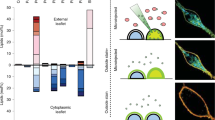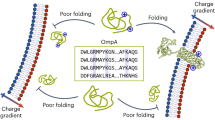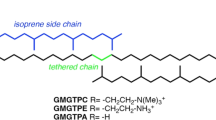Abstract
Freely suspended liposomes are widely used as model membranes for studying lipid–lipid and protein–lipid interactions. Liposomes prepared by conventional methods have chemically identical bilayer leaflets. By contrast, living cells actively maintain different lipid compositions in the two leaflets of the plasma membrane, resulting in asymmetric membrane properties that are critical for normal cell function. Here, we present a protocol for the preparation of unilamellar asymmetric phospholipid vesicles that better mimic biological membranes. Asymmetry is generated by methyl-β-cyclodextrin-catalyzed exchange of the outer leaflet lipids between vesicle pools of differing lipid composition. Lipid destined for the outer leaflet of the asymmetric vesicles is provided by heavy-donor multilamellar vesicles containing a dense sucrose core. Donor lipid is exchanged into extruded unilamellar acceptor vesicles that lack the sucrose core, facilitating the post-exchange separation of the donor and acceptor pools by centrifugation because of differences in vesicle size and density. We present two complementary assays allowing quantification of each leaflet’s lipid composition: the overall lipid composition is determined by gas chromatography–mass spectrometry, whereas the lipid distribution between the two leaflets is determined by NMR, using the lanthanide shift reagent Pr3+. The preparation protocol and the chromatographic assay can be applied to any type of phospholipid bilayer, whereas the NMR assay is specific to lipids with choline-containing headgroups, such as phosphatidylcholine and sphingomyelin. In ~12 h, the protocol can produce a large yield of asymmetric vesicles (up to 20 mg) suitable for a wide range of biophysical studies.
This is a preview of subscription content, access via your institution
Access options



Similar content being viewed by others
References
Lorent, J. H. et al. Structural determinants and functional consequences of protein affinity for membrane rafts. Nat. Commun. 8, 1219 (2017).
Lingwood, D. & Simons, K. Lipid rafts as a membrane-organizing principle. Science 327, 46–50 (2010).
Doktorova, M. et al. Cholesterol promotes protein binding by affecting membrane electrostatics and solvation properties. Biophys. J. 113, 2004–2015 (2017).
Op den Kamp, J. A. F. Lipid asymmetry in membranes. Annu. Rev. Biochem. 48, 47–41 (1979).
Verkleij, A. J. et al. The asymmetric distribution of phospholipids in the human red cell membrane. A combined study using phospholipases and freeze-etch electron microscopy. Biochim. Biophys. Acta 323, 178–193 (1973).
Fadok, V. A. et al. Exposure of phosphatidylserine on the surface of apoptotic lymphocytes triggers specific recognition and removal by macrophages. J. Immunol. 148, 2207–2216 (1992).
Perillo, V. L., Penalva, D. A., Vitale, A. J., Barrantes, F. J. & Antollini, S. S. Transbilayer asymmetry and sphingomyelin composition modulate the preferential membrane partitioning of the nicotinic acetylcholine receptor in Lo domains. Arch. Biochem. Biophys. 591, 76–86 (2016).
Vitrac, H., MacLean, D. M., Jayaraman, V., Bogdanov, M. & Dowhan, W. Dynamic membrane protein topological switching upon changes in phospholipid environment. Proc. Natl. Acad. Sci. USA 112, 13874–13879 (2015).
Hussain, N. F., Siegel, A. P., Ge, Y., Jordan, R. & Naumann, C. A. Bilayer asymmetry influences integrin sequestering in raft-mimicking lipid mixtures. Biophys. J. 104, 2212–2221 (2013).
Lin, Q. & London, E. The influence of natural lipid asymmetry upon the conformation of a membrane-inserted protein (perfringolysin O). J. Biol. Chem. 289, 5467–5478 (2014).
St. Clair, J. R., Wang, Q., Li, G. & London, E. in The Biophysics of Cell Membranes Vol. 19 (eds. Epand, R. & Ruysschaert, J. M.) 1–27 (Springer, Singapore, 2017).
Pautot, S., Frisken, B. J. & Weitz, D. A. Engineering asymmetric vesicles. Proc. Natl. Acad. Sci. USA 100, 10718–10721 (2003).
Redelmeier, T. E., Hope, M. J. & Cullis, P. R. On the mechanism of transbilayer transport of phosphatidylglycerol in response to transmembrane pH gradients. Biochemistry 29, 3046–3053 (1990).
Hope, M. J., Redelmeier, T. E., Wong, K. F., Rodrigueza, W. & Cullis, P. R. Phospholipid asymmetry in large unilamellar vesicles induced by transmembrane pH gradients. Biochemistry 28, 4181–4187 (1989).
Denkins, Y. M. & Schroit, A. J. Phosphatidylserine decarboxylase: generation of asymmetric vesicles and determination of the transbilayer distribution of fluorescent phosphatidylserine in model membrane systems. Biochim. Biophys. Acta 862, 343–351 (1986).
Takaoka, R., Kurosaki, H., Nakao, H., Ikeda, K. & Nakano, M. Formation of asymmetric vesicles via phospholipase D-mediated transphosphatidylation. Biochim. Biophys. Acta 1860, 245–249 (2017).
Bloj, B. & Zilversmit, D. B. Asymmetry and transposition rates of phosphatidylcholine in rat erythrocyte ghosts. Biochemistry 15, 1277–1283 (1976).
Herrmann, A., Zachowski, A. & Devaux, P. F. Protein-mediated phospholipid translocation in the endoplasmic reticulum with a low lipid specificity. Biochemistry 29, 2023–2027 (1990).
Cheng, H. T. & London, E. Preparation and properties of asymmetric large unilamellar vesicles: interleaflet coupling in asymmetric vesicles is dependent on temperature but not curvature. Biophys. J. 100, 2671–2678 (2011).
Szejtli, J. Introduction and general overview of cyclodextrin chemistry. Chem. Rev. 98, 1743–1754 (1998).
Bozelli, J. C. Jr., Hou, Y. H. & Epand, R. M. Thermodynamics of methyl-beta-cyclodextrin-induced lipid vesicle solubilization: effect of lipid headgroup and backbone. Langmuir 33, 13882–13891 (2017).
Heberle, F. A. et al. Subnanometer structure of an asymmetric model membrane: interleaflet coupling influences domain properties. Langmuir 32, 5195–5200 (2016).
Mui, B. L., Cullis, P. R., Evans, E. A. & Madden, T. D. Osmotic properties of large unilamellar vesicles prepared by extrusion. Biophys. J. 64, 443–453 (1993).
Evans, E., Heinrich, V., Ludwig, F. & Rawicz, W. Dynamic tension spectroscopy and strength of biomembranes. Biophys. J. 85, 2342–2350 (2003).
Homan, R. & Pownall, H. J. Transbilayer diffusion of phospholipids: dependence on headgroup structure and acyl chain length. Biochim. Biophys. Acta 938, 155–166 (1988).
Marsh, D. Handbook of Lipid Bilayers 2nd edn (CRC Press, Boca Raton, FL, 2013).
Pomorski, T. G. & Menon, A. K. Lipid somersaults: uncovering the mechanisms of protein-mediated lipid flipping. Prog. Lipid Res. 64, 69–84 (2016).
Son, M. & London, E. The dependence of lipid asymmetry upon polar headgroup structure. J. Lipid Res. 54, 3385–3393 (2013).
Son, M. & London, E. The dependence of lipid asymmetry upon phosphatidylcholine acyl chain structure. J. Lipid Res. 54, 223–231 (2013).
Nakano, M. et al. Flip-flop of phospholipids in vesicles: kinetic analysis with time-resolved small-angle neutron scattering. J. Phys. Chem. B 113, 6745–6748 (2009).
Eicher, B. et al. Joint small-angle X-ray and neutron scattering data analysis of asymmetric lipid vesicles. J. Appl. Crystallogr. 50, 419–429 (2017).
Markones, M. et al. Engineering asymmetric lipid vesicles: accurate and convenient control of the outer leaflet lipid composition. Langmuir 34, 1999–2005 (2018).
Eicher, B. et al. Intrinsic curvature-mediated transbilayer coupling in asymmetric lipid vesicles. Biophys. J. 114, 146–157 (2018).
Marquardt, D. et al. 1H NMR shows slow phospholipid flip-flop in gel and fluid bilayers. Langmuir 33, 3731–3741 (2017).
Cheng, H. T., Megha & London, E. Preparation and properties of asymmetric vesicles that mimic cell membranes: effect upon lipid raft formation and transmembrane helix orientation. J. Biol. Chem. 284, 6079–6092 (2009).
Lin, Q. & London, E. Preparation of artificial plasma membrane mimicking vesicles with lipid asymmetry. PLoS ONE 9, e87903 (2014).
Li, G. et al. Efficient replacement of plasma membrane outer leaflet phospholipids and sphingolipids in cells with exogenous lipids. Proc. Natl. Acad. Sci. USA 113, 14025–14030 (2016).
Kishimoto, Y. & Radin, N. S. A reaction tube for methanolysis; instability of hydrogen chloride in methanol. J. Lipid Res. 6, 435–436 (1965).
Kucerka, N., Pencer, J., Sachs, J. N., Nagle, J. F. & Katsaras, J. Curvature effect on the structure of phospholipid bilayers. Langmuir 23, 1292–1299 (2007).
Huang, Z. & London, E. Effect of cyclodextrin and membrane lipid structure upon cyclodextrin-lipid interaction. Langmuir 29, 14631–14638 (2013).
Chiantia, S., Schwille, P., Klymchenko, A. S. & London, E. Asymmetric GUVs prepared by MbetaCD-mediated lipid exchange: an FCS study. Biophys. J. 100, L1–L3 (2011).
Lin, Q. & London, E. Ordered raft domains induced by outer leaflet sphingomyelin in cholesterol-rich asymmetric vesicles. Biophys. J. 108, 2212–2222 (2015).
Acknowledgements
The authors acknowledge support from University of Windsor startup funds (to D.M.); Natural Sciences and Engineering Research Council of Canada (NSERC) funding ref. no. 2018-04841 (to D.M.); Austrian Science Fund (FWF) project P27083 (to G.P.); U.S. National Science Foundation (NSF) grant DMR 1709035 (to E.L.); NSF grant MCB-1817929 (to F.A.H.); and the Laboratory Directed Research and Development Program of Oak Ridge National Laboratory (to F.A.H., J.K., and R.F.S.), managed by UT-Battelle for the U.S. Department of Energy under contract no. DE-AC05 00OR22725.
Author information
Authors and Affiliations
Contributions
M.D., F.A.H., and D.M. wrote the manuscript; M.D., F.A.H., B.E., G.P., E.L., R.F.S., J.K., and D.M. provided input and edited the manuscript; M.D., F.A.H., B.E., and D.M. conducted the experiments.
Corresponding author
Ethics declarations
Competing interests
The authors declare no competing interests.
Additional information
Publisher’s note: Springer Nature remains neutral with regard to jurisdictional claims in published maps and institutional affiliations.
Related links
Key references using this protocol
1. Eicher, B. et al. Biophys. J. 114, 146–157 (2018): https://doi.org/10.1016/j.bpj.2017.11.009
2. Eicher, B. et al. J. Appl. Crystallogr. 50, 419–429 (2017): https://doi.org/10.1107/S1600576717000656
3. Marquardt, D. et al. Langmuir 33, 3731–3741 (2017): https://doi.org/10.1021/acs.langmuir.6b04485
4. Heberle, F. A. et al. Langmuir 32, 5195–5200 (2016): https://doi.org/10.1021/acs.langmuir.5b04562
Supplementary information
Rights and permissions
About this article
Cite this article
Doktorova, M., Heberle, F.A., Eicher, B. et al. Preparation of asymmetric phospholipid vesicles for use as cell membrane models. Nat Protoc 13, 2086–2101 (2018). https://doi.org/10.1038/s41596-018-0033-6
Published:
Issue Date:
DOI: https://doi.org/10.1038/s41596-018-0033-6
This article is cited by
-
Liposomal Pharmaceutical Products: Methods of Analytical Characterization and Quality Control
Pharmaceutical Chemistry Journal (2024)
-
Protein–lipid charge interactions control the folding of outer membrane proteins into asymmetric membranes
Nature Chemistry (2023)
-
Open-channel structure of a pentameric ligand-gated ion channel reveals a mechanism of leaflet-specific phospholipid modulation
Nature Communications (2022)
-
Interdigitation-Induced Order and Disorder in Asymmetric Membranes
The Journal of Membrane Biology (2022)
-
Plasma membranes are asymmetric in lipid unsaturation, packing and protein shape
Nature Chemical Biology (2020)
Comments
By submitting a comment you agree to abide by our Terms and Community Guidelines. If you find something abusive or that does not comply with our terms or guidelines please flag it as inappropriate.



